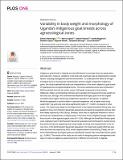| dc.description.abstract | Indigenous goat breeds in Uganda are classified based on average body size parameters
and coat color. However, variations in the body size of animals may be influenced by several
factors, including management and the environment. To understand the effect of the agro-
ecological zone on the physical characteristics and live weight of Uganda’s indigenous
goats, this study evaluated the body size characteristics of the three indigenous goat breeds
of Uganda across ten agroecological zones. The cross-sectional survey was conducted in
323 households from the ten zones, where 1020 goats composed of three breeds
(Mubende, Kigezi, and Small East African) were sampled and measured for body weight, lin-
ear body size, and age. We confirmed that Mubende and Kigezi goats from the original
homeland had a higher mean body weight than reported in FAO reports. In addition,
Mubende appeared to perform better in pastoral rangelands, with a higher mean body
weight (38.1 kg) and body size being significantly higher (P < 0.0001) compared to other
zones. The mean body weight for the Kigezi breed in the original homeland (34 kg) was com-
parable to those from Western Savannah grasslands and pastoral rangelands and less than
that initially reported by FAO (30 kg). Similarly, there was no significant difference in the lin-
ear body size characteristics of Kigezi goats in the home zone of highland ranges relative to
those found in other agroecological zones (P > 0.05). Although the Small East African goats
were originally found in Northwestern Savannah grassland and Northeastern dryland zones,
they performed poorly regarding mean body weight and body size characteristics in the for-
mer zone. In the Northwestern Savannah grasslands, the mean body weight (23.8 kg) was
even less than that reported by FAO, which ranged between 25 and 30 kg. Finally, we con-
firmed that Mubende and Kigezi goats are significantly heavier than small East African goats
(p � 0.0001). The results of this study can be useful in designing precise management strat-
egies to improve indigenous goat productivity in different environments in Uganda. | en_US |

